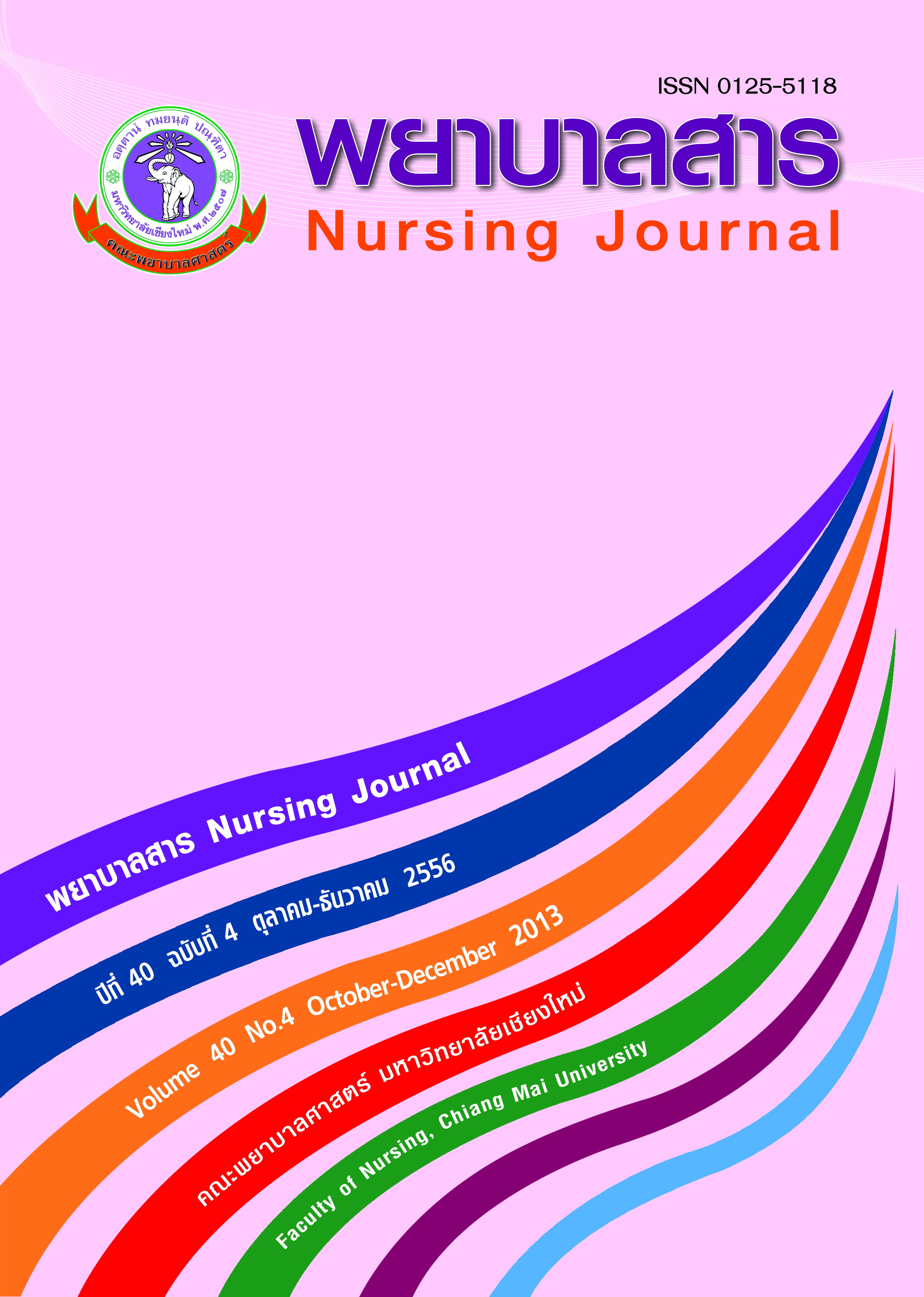ปัจจัยทำนายพฤฒพลังของประชากรเขตเมือง จังหวัดเชียงใหม่
Keywords:
พฤฒพลัง, ปัจจัยทำนายพฤฒพลัง, Active Ageing, Factors Predicting Active AgeingAbstract
บทคัดย่อ
การส่งเสริมให้ประชาชนทุกคนมีพฤฒพลังหรือการเตรียมตัวเข้าสู่วัยสูงอายุเป็นวิธีการที่นำไปสู่การมีคุณภาพชีวิตที่ดีเมื่อเข้าสู่วัยสูงอายุ พฤฒพลังเป็นกระบวนการที่เหมาะสม ที่นำไปสู่การมีสุขภาพดี การมีส่วนร่วม และการมีหลักประกันที่มั่นคง ในการที่จะเสริมสร้างคุณภาพชีวิตเมื่อสูงวัย (World Health Organization.[WHO], 2002) การวิจัยแบบหาความสัมพันธ์เชิงทำนายนี้ใช้กรอบแนวคิดพฤฒพลังขององค์การอนามัยโลกมีวัตถุประสงค์เพื่อศึกษาระดับพฤฒพลังของประชากรเขตเมือง จังหวัดเชียงใหม่ และความสามารถในการทำนายพฤฒพลังของ ปัจจัยส่วนบุคคล ความรู้เกี่ยวกับการสูงอายุ ทัศนคติต่อการสูงอายุ และการสนับสนุนทางสังคมเลือกกลุ่มตัวอย่างโดยการสุ่มตัวอย่างหลายขั้นตอน ได้กลุ่มตัวอย่างจำนวน 398 คน ทั้งเพศชายและเพศหญิง อายุ40-59 ปี อาศัยอยู่ในเขตอำเภอเมือง จังหวัดเชียงใหม่ เครื่องมือวิจัย ประกอบด้วย แบบสอบถามเกี่ยวกับข้อมูลส่วนบุคคล แบบสอบถามพฤฒพลัง ใช้แบบสอบถามพฤฒพลังของผู้สูงอายุของ สุปราณี แตงวงษ์, ศากุล ช่างไม้,ลัดดาวรรณ เสียงอ่อน, และ วาริศา เพชรธีรานนท์ (2552) ที่สร้างขึ้นตามกรอบนโยบายพฤตพลังขององค์การอนามัยโลก (WHO, 2002) แบบสอบถามความรู้เกี่ยวกับการสูงอายุ (Facts on Ageing Quiz: FAQ) ของพาลมอร์(Palmore, 1977) ฉบับภาษาไทยของวิไลพร รังควัต (Runkawatt, 2007) มีค่าความตรงตามเนื้อหา เท่ากับ 0.97แบบสอบถามทัศนคติต่อการสูงอายุ ผู้วิจัยแปลมาจากแบบสอบถามทัศนคติต่อการสูงอายุ (Attitudes towardAgeing Questionnaire: AAQ) ของเลดลอ และคณะ (Laidlaw, Power, Schmidt, & the WHOQOL-OLDgroup, 2007) แล้วให้ผู้เชี่ยวชาญด้านภาษาอังกฤษและภาษาไทย แปลกลับจากภาษาไทยเป็นภาษาอังกฤษ และแบบสอบถามการสนับสนุนทางสังคม ดัดแปลงมาจากแบบวัดการสนับสนุนทางสังคมของผู้สูงอายุหัวใจวายเลือดคั่งของ เยาวภา บุญเที่ยง (2546) ที่สร้างขึ้นตามแนวคิดของคอบบ์ (Cobb, 1976) ร่วมกับแนวคิดของเชฟเฟอร์คอยน์ และลาซาราส (Schaefer, Coyne, & Lazarus, 1981) มีค่าดัชนีความตรงตามเนื้อหา เท่ากับ 0.80 ตรวจสอบความเชื่อมั่นโดยหาค่าสัมประสิทธิ์อัลฟาของครอนบาค ได้ค่าความเชื่อมั่นของแบบสอบถามพฤฒพลังของประชากรไทย แบบสอบถามความรู้เกี่ยวกับการสูงอายุ แบบสอบถามทัศนคติต่อการสูงอายุ และแบบสอบถามการสนับสนุนทางสังคม เท่ากับ 0.90, 0.87, 0.88 และ 0.91 ตามลำดับ รวบรวมข้อมูลภายหลังโครงการวิจัยได้รับความเห็นชอบจากคณะกรรมการจริยธรรมการวิจัย ระหว่างเดือนกรกฎาคม ถึงสิงหาคม พ.ศ. 2554 วิเคราะห์ข้อมูลโดยใช้สถิติเชิงพรรณนา และการวิเคราะห์ถดถอยพหุคูณแบบปกติ
ผลการวิจัย พบว่า
1. กลุ่มตัวอย่างมีพฤฒพลังโดยรวม พฤฒพลังด้านสุขภาพ ด้านการมีส่วนร่วม และด้านความมั่นคงอยู่ในระดับสูง2. การสนับสนุนทางสังคม ทัศนคติต่อการสูงอายุ รายได้ และเพศหญิง สามารถร่วมกันทำนายพฤฒพลังได้ร้อยละ 17.87 (R2 = 0.1787, F = 6.4266, p<0.001)3. ความรู้เกี่ยวกับการสูงอายุ อายุ สถานภาพสมรส และการศึกษา ไม่สามารถทำนายพฤฒพลังได้
ผลการวิจัยครั้งนี้สามารถนำไปพัฒนาโปรแกรมการส่งเสริมพฤฒพลังให้กับประชาชน ในการทำวิจัยครั้งต่อไปควรมีการศึกษาปัจจัยทำนายพฤฒพลังในแต่ละด้าน และปัจจัยอื่นที่อาจมีความเกี่ยวข้องกับพฤฒพลังและศึกษาเปรียบเทียบปัจจัยทำนายพฤฒพลังของประชากรในเขตเมืองและเขตชนบท
คำสำคัญ: พฤฒพลัง ปัจจัยทำนายพฤฒพลัง
Abstract
Encouraging active ageing in people as they get older can enhance quality of life. Active ageingis the process of optimizing opportunities for health, participation and security in order to enhancequality of life as people age World Health Organization. (WHO, 2002). This predictive correlationaldescriptive research study used active ageing policy framework of the world health organization,aimed to determine the level of active ageing among a population in the Mueang District of ChiangMai Province, and to study factors (personal factors, knowledge about ageing, attitude towards ageing,and social support) that predict active ageing. Subjects were selected by multi-stage samplingtechnique. The 398 subjects included male and female adults aged 40-59 years livinng in an urbanarea (Mueang District) of Chiang Mai Province were selected. The research tools included a demographicdata recording form. The active ageing questionnaire, used active ageing of elderly questionnaire bySupranee Tangwong, Sakol Changmai, Laddawan Seangorn, and Warisa Phetteeranonta that developedbase on the active ageing policy framework of the world health organization (WHO, 2002) The knowledgeabout ageing questionnaire (Facts on Ageing Quiz: FAQ) by Palmore, (1977), Thai edition by WilaipornRunkawatt (2007), the content validity index was .97. The attitude towards ageing questionnaire, theresearcher had translate from the attitudes toward Ageing Questionnaire (AAQ) by Laidlaw, Power,Schmidt, & the WHOQOL-OLD group (2007), then back translated by specialist of English and Thailangue. And the social support questionnaire that was modified from Social Support Questionnaireof Congestive Heart Failure Elderly by Yaowapha Boonthiang (2002), the content validity index ofthe questionnaire was 0.80. The reliability of the questionnaires were tested. The Cronbach’s alphacoefficient of active ageing questionnaire, knowledge about ageing questionnaire, attitude towardageing questionnaire and social support questionnaire were 0.90, 0.87, 0.88 and 0.91 respectively.Data were collected from July and August 2011 after the research project was approved by the ethiccommittee. Data were analyzed using descriptive statistics and all enter multiple regression analysis.
The results of study
1. Overall active ageing, health, participation and security were at a high level.
2. Social support, attitude towards ageing, income and female gender together could explain17.87% of variance in active ageing (R2 = 0.1787, F = 6.4266, p<0.001).
3. Knowledge about ageing, age, marital status, and education level did not explain variationin active ageing.The results from this study can be used to develope a program to promote active ageingfor this population. Future studies should study predictors of each active ageing domain and otherfactors that may be correlated with active ageing. A comparative study examining factors predictingactive ageing among populations in urban and rural areas is also recommended.
Key words: Active Ageing, Factors Predicting Active Ageing
Downloads
How to Cite
Issue
Section
License
บทความที่ได้รับการตีพิมพ์เป็นลิขสิทธิ์ของวารสารพยาบาลสาร
ข้อความที่ปรากฏในบทความแต่ละเรื่องในวารสารวิชาการเล่มนี้เป็นความคิดเห็นส่วนตัวของผู้เขียนแต่ละท่านไม่เกี่ยวข้องกับมหาวิทยาลัยเชียงใหม่ และคณาจารย์ท่านอื่นๆในมหาวิทยาลัยฯ แต่อย่างใด ความรับผิดชอบองค์ประกอบทั้งหมดของบทความแต่ละเรื่องเป็นของผู้เขียนแต่ละท่าน หากมีความผิดพลาดใด ๆ ผู้เขียนแต่ละท่านจะรับผิดชอบบทความของตนเองแต่ผู้เดียว






